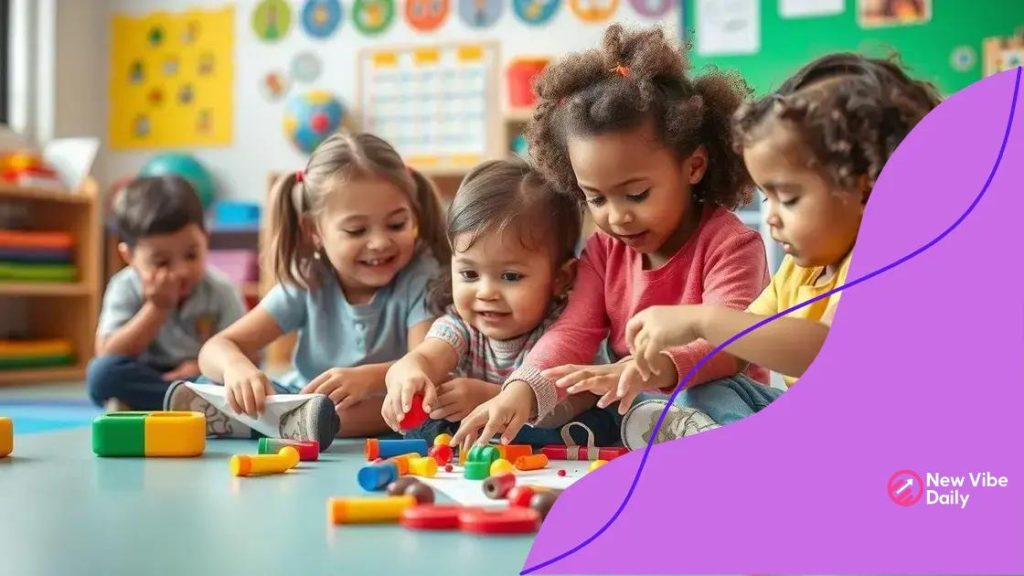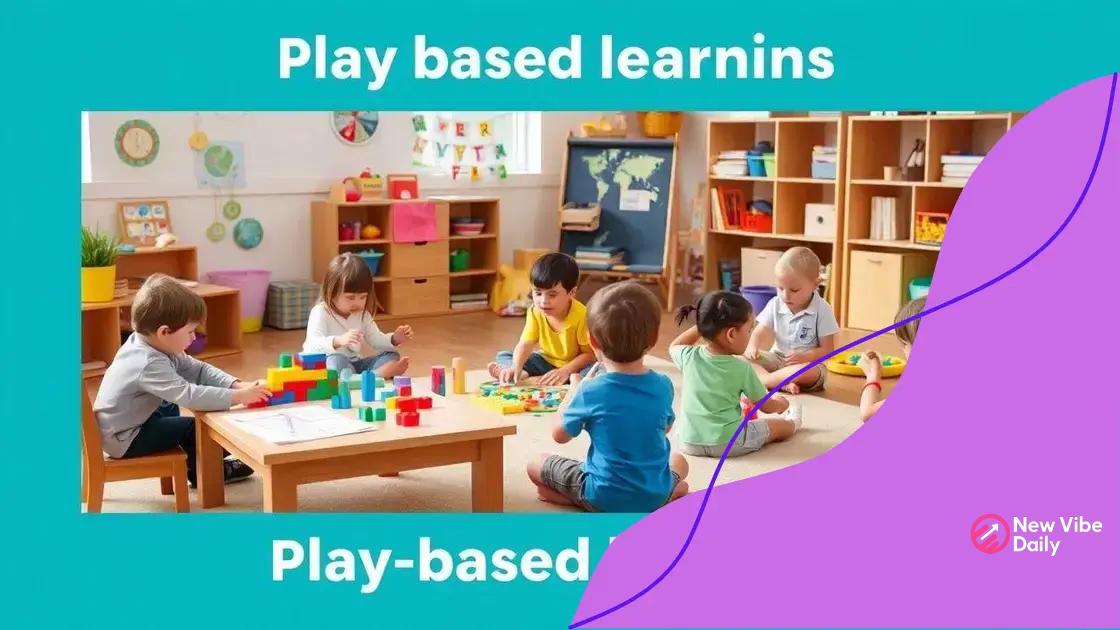Importance of play-based learning for child development

Play-based learning is an educational approach where children develop essential skills through engaging, hands-on activities that promote social interaction, creativity, and emotional resilience.
Importance of play-based learning cannot be underestimated when it comes to shaping a child’s educational journey. Have you ever noticed how children thrive while playing? Let’s dive into how this method can transform their learning experience.
Understanding play-based learning
Understanding play-based learning is essential for parents and educators. This approach encourages children to explore, experiment, and learn through play.
What is Play-Based Learning?
Play-based learning is an educational method where children engage in play to promote learning and development. Through various activities, children use their imagination, social skills, and creativity. This type of learning allows for discovery and self-expression.
Key Characteristics of Play-Based Learning
- Child-directed activities that focus on fun.
- Integration of learning into playtime.
- A focus on collaboration and communication among peers.
- Encouragement of problem-solving skills through challenges.
Moreover, play-based learning creates an environment where children feel safe to take risks. They can try new things without the fear of making mistakes. This is crucial for their emotional and social development. Children learn to navigate relationships, resolve conflicts, and build resilience through shared play experiences.
Another important aspect is that play can be both structured and unstructured. Structured play has specific goals, while unstructured play allows children to create their own narratives and explore freely. Both methods support cognitive development and enhance critical thinking skills.
The Role of Educators
In play-based settings, educators facilitate learning by providing resources and guiding interactions. They observe children’s interests and use these observations to shape learning activities. This responsive approach helps to connect play with educational objectives.
Additionally, children often engage with a variety of materials that inspire creativity. Things like blocks, art supplies, and costumes can transform ordinary spaces into imaginative worlds. Educational games can also be integrated, maintaining fun while reinforcing important concepts.
Benefits of Play-Based Learning
- Enhances social skills and teamwork.
- Boosts creativity and imagination.
- Improves emotional regulation and coping strategies.
Ultimately, understanding play-based learning highlights its importance in fostering a love for learning. It prepares children for academic success while helping them develop vital life skills. Encouraging play in educational settings is not just beneficial; it’s critical for holistic development.
Benefits of play-based learning
The benefits of play-based learning extend far beyond just having fun. This approach fosters essential life skills, emotional well-being, and academic readiness.
Enhanced Social Skills
Through play-based learning, children interact with their peers, which helps them develop social skills. They learn how to communicate effectively, share, and work collaboratively. These interactions also promote empathy and understanding in diverse groups.
Cognitive Development
Play stimulates cognitive development by encouraging critical thinking and problem-solving. When children engage in play, they explore their environment, ask questions, and seek solutions. This curiosity drives their learning and helps them grasp complex concepts in a fun way.
- Increased attention span.
- Enhanced creativity and imagination.
- Improved ability to focus on tasks.
The integration of educational games into play reinforces learning objectives without pressure. Children develop a love for learning when they see education as enjoyable. They naturally absorb information while they play.
Emotional Development
Emotional resilience is another benefit of play-based learning. Children encounter challenges during play, which teaches them how to cope with frustration and setbacks. They also experience joy and excitement, which boost self-esteem and confidence.
Realizing their strengths and weaknesses during play helps children understand their emotions better. They learn to express their feelings and handle conflicts in a constructive manner. This emotional intelligence is critical as they grow up.
Physical Development
Play-based activities encourage movement, contributing to physical development as well. From running and jumping to fine motor skills like building and drawing, play fosters both gross and fine motor skills. By being active, children also develop coordination and balance.
- Improved muscle strength.
- Increased energy levels.
- Better overall health and fitness.
In conclusion, embracing play-based learning can significantly benefit children. It prepares them for school and life by promoting necessary skills in a dynamic and enjoyable way.
How to implement play-based learning

Implementing play-based learning effectively requires a thoughtful approach. This method not only engages children but also fosters their development in a fun and dynamic way.
Creating an Inviting Environment
The first step is to create a learning environment that encourages exploration. Classrooms should be colorful and filled with a variety of materials that invite participation. Things like building blocks, art supplies, and learning games allow children to use their imagination. An organized and safe space helps children feel comfortable while they play.
Integrating Play into the Curriculum
When integrating play into the curriculum, educators should connect play activities with learning goals. Start by identifying the skills children need to develop. Then, design activities that encourage these skills through play. For example, if you want to promote teamwork, incorporate group games that require cooperation.
- Use themes that interest the children.
- Provide open-ended materials for creativity.
- Encourage role-playing scenarios to enhance empathy and social skills.
Regularly observe children to understand their interests. Adjust the available activities based on these interests to keep them engaged. This responsiveness ensures that learning remains fun and relevant.
Encouraging Child-Led Exploration
Another vital aspect is allowing children to lead their own play. When children have autonomy, they feel empowered to make choices. This leads to deeper engagement and more meaningful learning experiences. Educators can facilitate this by asking open-ended questions that promote critical thinking.
For instance, if children are building with blocks, ask them about their structures. Questions like, “What will happen if you make it taller?” prompt them to think critically while they play. This approach fosters a love for learning, as children realize their ideas and choices significantly impact their activities.
Parental Involvement
Involving parents is also essential in implementing play-based learning. Educators should communicate the benefits of this approach and encourage parents to support it at home. They can suggest activities that parents can do with their children, like simple science experiments or arts and crafts.
- Share resources and ideas with families.
- Encourage outdoor play and exploration.
- Invite parents to participate in classroom activities.
By engaging families, children can experience continuity between home and school, reinforcing their learning through play. Implementing play-based learning is not just about activities; it’s about creating a culture that values and prioritizes play as a fundamental aspect of education.
Challenges in play-based learning
Though play-based learning offers many benefits, it also presents certain challenges that educators and parents must address. Understanding these obstacles is vital for effective implementation.
Lack of Understanding
Many educators and parents may not fully understand what play-based learning entails. This misunderstanding can lead to skepticism about its effectiveness. Some may believe that play is simply a way to pass time rather than a legitimate teaching method.
Time Management
Another significant challenge is finding enough time in the curriculum for play. Educators often feel pressure to cover academic content, which can lead to prioritizing traditional teaching methods over play-based activities. Balancing these needs requires careful planning and creativity.
- Integrating play into existing subjects.
- Creating flexible schedules that accommodate play.
- Using transitions effectively to move between structured and unstructured activities.
Time management becomes critical for ensuring children engage in meaningful play without sacrificing academic standards.
Resource Limitations
Resource limitations can also pose challenges to implementing play-based learning. Not all schools have access to the materials and space needed for effective play-based activities. Insufficient supplies can hinder the creativity involved in play.
Prioritizing resources is key. Schools can seek partnerships with local organizations or community members to gather materials. Donations from parents can also enrich classroom supplies.
Assessing Learning Outcomes
Assessing children’s learning through play can be complex. Traditional assessment methods may not capture the skills children develop during play-based activities. Educators might struggle to find appropriate ways to measure outcomes.
- Utilizing observation checklists.
- Implementing portfolios to document progress.
- Incorporating self-assessments to allow children to reflect on their learning.
Finding effective assessment strategies is essential to validate the impact of play-based learning on children’s development.
Facing these challenges head-on helps educators improve their play-based learning approaches. It allows for a better appreciation of children’s developmental needs and offers a more enriching educational experience.
Real-life examples of play-based learning
Real-life examples of play-based learning showcase how this approach works in various settings. These examples highlight the creativity and engagement children experience while learning.
Outdoor Learning Environments
In many schools, outdoor classrooms provide incredible opportunities for play-based learning. Children explore nature, collect leaves, and use them for art projects or science experiments. This type of engagement allows them to learn about the environment while being active.
Role-Playing Activities
Role-playing is another excellent way to implement play-based learning. In a classroom, children might set up a grocery store where they take turns being customers and cashiers. Not only does this activity enhance their social skills, but it also teaches them about money, math, and communication.
- Children learn to negotiate prices.
- They practice taking turns and sharing.
- They develop important vocabulary and language skills.
This method encourages creativity as children invent scenarios and stories to act out.
Creative Arts and Crafts
Art projects are a common feature of play-based classrooms. For example, children may work together to create a large mural. As they paint, they discuss colors, shapes, and ideas. This collaborative effort fosters teamwork and helps children express their creativity.
Additionally, these activities promote fine motor skills as children cut, glue, and assemble materials. Such hands-on learning experiences reinforce academic skills in a playful manner.
STEM Learning through Play
Integrating STEM concepts into play is increasingly popular. In a classroom, children might build structures using blocks or LEGO. They learn about balance, gravity, and spatial awareness through these activities.
- Children experiment with designs and functions.
- They learn to solve problems creatively.
- They practice critical thinking skills.
By encouraging kids to explore while they play, educators nurture a love for science, technology, engineering, and math.
Community Involvement
Some schools partner with local organizations to create play-based learning experiences. For instance, a library might hold a workshop where children act out stories. This blend of literacy and play engages children in both reading and comprehension skills.
Incorporating community resources enriches the learning experience, making education relevant and enjoyable.
FAQ – Frequently Asked Questions about Play-Based Learning
What is play-based learning?
Play-based learning is an educational approach where children learn through play, allowing them to explore, experiment, and develop skills in a fun and engaging manner.
What are the benefits of play-based learning?
The benefits include improved social skills, enhanced cognitive development, emotional resilience, and a love for learning through hands-on and creative activities.
How can educators implement play-based learning in the classroom?
Educators can create inviting environments, integrate play into the curriculum, encourage child-led exploration, and involve parents in the learning process.
What challenges might arise with play-based learning?
Challenges include a lack of understanding from educators and parents, time management issues, resource limitations, and difficulties in assessing learning outcomes.






